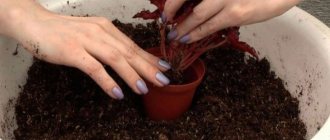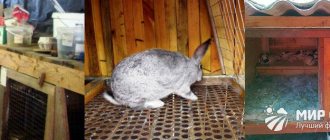Eye diseases in rabbits, unless they are a symptom of an infectious disease, are no different from eye diseases in other mammals, including humans. To the point that a rabbit's eye can be examined and diagnosed by an ophthalmologist.
If conjunctivitis is a symptom of an infectious disease in a rabbit, it is pointless to treat it without eliminating the underlying cause. In this case, the disease is treated first, and symptomatic treatment is applied to the eyes, aimed at making the rabbit feel better.
Diseases of rabbits related only to the eyes are most often of a hereditary nature. May result from mechanical damage, chemical eye irritation, or dacryocystitis, which usually results from congenital malposition of the rabbit's molars.
Eye diseases of an infectious nature must be considered in conjunction with treatment of the underlying disease in a rabbit, so there is no point in dwelling on them in this case.
Non-infectious eye diseases in rabbits are generally treated in the same way as in other animals. The only difference is in size.
Healthy animals have clean eyes, they are completely open and shiny.
Why do rabbits often have watery and sour eyes?
Pets' eyes often become watery and sour due to debris from hay, grass, and dust. Similar problems may arise due to violation of containment conditions. In particular, the cage should not be in a draft. You need to clean the tray 2 times. per day. It is prohibited to spray perfume or household chemicals near rabbits. Watery eyes should be washed with chamomile infusion and strong tea. Such procedures will also be useful for preventive purposes.
Discharge may appear due to a clogged nasolacrimal duct. If this happens, you need to show the rabbit to a veterinarian. The irritating factor should also be identified. This is usually unsuitable bedding (straw or sawdust) that needs to be replaced.
Diseases of the visual organs in rabbits can develop due to poor wear of teeth or disturbances in their development. The animal grows so-called hooks that touch the nasolacrimal duct and cause lacrimation. It is imperative to contact a veterinarian, since the rabbit will not be able to grind them off on its own. To prevent hooks from appearing, animals need to be given wood twigs.
Prevention of eye diseases
Rabbits are kept in accordance with zoohygienic standards. The quality of hay for feeding and bedding is determined organoleptically. If the appearance and smell are alarming, replace the roughage with high-quality food. Rabbits should be fed complete granulated feed. Hay and green feed are used as supplements; you can do without them. Rabbits are offered twig food to grind down their teeth.
Animals are dewormed at least once every six months and vaccinated against myxomatosis and hemorrhagic septicemia in accordance with the instructions for use. Animals are regularly examined, and rabbits with pathological symptoms are removed.
Inflammatory and infectious diseases
Conjunctivitis
The cause of conjunctivitis can be infectious diseases, an allergic reaction, or sawdust or hay that gets into the eyes, a cage that is not cleaned in time, or a lack of vitamins.
Symptoms of conjunctivitis are:
- rabbits with red eyes;
- lacrimation;
- discharge of pus and, as a result, sticky eyelids.
Conjunctivitis can also occur in small rabbits. Infectious conjunctivitis in rabbits can be transmitted by a female rabbit. Usually the eyes of baby rabbits open at 10-12 days from birth. If the rabbits' eyes are stuck together, they need to be washed with chamomile several times. The baby rabbit's open eye should be clean and mobile, the mucous membrane should be transparent, should not fester, and there should be no redness around the eye. If one of the listed characteristics is in doubt, or there is constant wetness around the rabbit’s eye, then you need to consult an ophthalmologist.
Keratitis
This is an inflammation of the cornea. In such cases, the veterinarian prescribes anti-inflammatory ointments or drops to rinse the eyes. In some cases, drugs for corneal regeneration are also prescribed. Sometimes antibiotics are prescribed. The cause of keratitis can be exogenous factors, that is, those factors that affect the cornea itself. Endogenous factors that penetrate through the circulatory system can also be the cause.
A rabbit develops keratitis if:
- clouding of the mucous membrane;
- violation of the specularity of the shell;
- purulent discharge;
- squinted eye.
Uveitis
From Greek “ueva” is translated as “grape”. In appearance, the choroid resembles a bunch of grapes. Uveitis is an inflammation of the choroid of the eyeball.
The causes may be infections of viral or bacterial etiology, helminthiases, eye or head injuries.
Symptoms:
- Increased pupil size;
- lacrimation;
- Adhesions in the lens and iris;
- Change in the shape of the lens.
To prevent the formation of adhesions, eye drops and non-steroidal anti-inflammatory drugs are prescribed.
Dacryocystitis
Dacryocystitis is a disease that is a consequence of another illness. The main symptom is that the rabbit’s eyes fester. In some cases, infected gums and teeth may be the cause. Dacryocystitis is often a consequence of rhinitis or conjunctivitis. If your rabbit's eyes are stuck together, they need to be washed. When the eye opens, you should contact your veterinarian for advice.
After determining the cause of the disease, treatment is carried out with a number of anti-inflammatory drugs.
Myxomatosis
The cause is infection with the myxoma virus, which is transmitted by blood-sucking or rodents. This is one of the most dangerous diseases. In most cases, the animal cannot be cured and must be slaughtered.
The rabbit's eyes are stuck together, swollen, the eyelids swell and droop. Local nodular formations appear throughout the body. When affected by myxomatosis, a nodular bump can be observed near the rabbit's anus. The incubation period of myxomatosis is from 2 to 20 days.
In cases of detection of a dangerous disease, it is necessary to notify the veterinary sanitary service. A veterinary service specialist selects material from the affected area of a sick rabbit and sends it for examination. If the diagnosis is confirmed, quarantine will be established for a period of 2 weeks, unless there are recurrent illnesses.
Keratitis
Inflammation of the cornea of the eyeball. The causes of the disease are the same as those of conjunctivitis.
The main symptom of keratitis: clouding of the cornea. With purulent keratitis, the cloudiness will be yellow. In addition to clouding, there is photophobia, exfoliated particles of the epithelium, and growth of the cornea with additional blood vessels.
Treatment of keratitis
Eliminate the cause and prescribe eye ointments or drops with antibiotics.
Congenital
Congenital diseases include those that arise as a result of abnormalities during fetal development or are hereditary.
Cataract
This is a disease that causes darkening of the lens of the eyeball, as a result of which its capacity is significantly reduced. Since the lens acts as a conductor that transmits light, clouding affects visual acuity. In case of severe clouding, the eye completely loses its ability to transmit visual information.
The main reason, according to doctors, is the mother’s poor diet or the presence of infectious or parasitic diseases during pregnancy. Congenital cataracts occur in the fetus at the formation stage, so identifying a specific cause is problematic.
Symptoms:
- clouding of the lens, which looks like a whitish spot blocking the pupil;
- white or translucent discharge from the eyes;
- swelling of the eyes;
- disorientation in space;
- the formation of a white corner on the iris of the eye.
Diagnosis: the diagnosis is made by a veterinarian based on an external examination and additional research. It is necessary not only to make sure that it is a cataract, and not a similar infectious or parasitic disease, but also to identify the cause. The disease is not always congenital; accordingly, the cause may be an infection of the visual organs.
Cultures are performed, and urine and blood tests are taken to identify the presence of the pathogen. If none are found, the cataract is considered congenital.
Treatment: Since cataract is a denaturation of the protein that makes up the lens, treatment involves removing the damaged area. Denatured protein cannot be returned to its original state, just as it is impossible to make the white of an egg liquid and translucent again after frying.
However, treatment is not limited to removal. If the cause is the activity of pathogenic organisms, then drug therapy is carried out to prevent relapse.
Much depends on the stage at which treatment is carried out, so it is extremely important to consult a specialist immediately after the appearance of characteristic symptoms.
Important! If surgery is performed at the last stage, there is a high chance of developing glaucoma.
Glaucoma
Occurs due to increased pressure inside the eyeball. As a result, there is a gradual decrease in visual acuity, which ultimately ends in blindness. With constant increased pressure of the fluid inside the eye, the retinal cells responsible for transmitting visual information die.
Congenital glaucoma occurs due to poor genetics. If the father or mother has been diagnosed with glaucoma, then the chance of giving birth to young animals with this disease increases several times. An alternative reason is poor nutrition or the presence of any infectious diseases in the rabbit during gestation, which is reflected in the form of malformations.
Glaucoma in a rabbit Symptoms:
- bulging eye;
- decreased vision, which leads to partial disorientation;
- redness of the white of the eye.
Diagnosis: the diagnosis is made by a veterinarian after an external examination and measurement of intraocular pressure. After this, the specialist determines the degree of neglect and decides how to treat the animal and whether this makes sense.
It is worth understanding that treating an old rabbit that has several years of life left is quite dangerous, so you should not blame the doctor for inaction.
Treatment: identifying this disease is not easy even in humans, not to mention animals that cannot talk about the problem. As a result, this leads to the fact that the rabbit comes to the veterinarian at the last or penultimate stage, when it is already useless to treat the organ. In most cases, the eye is removed, after which symptomatic therapy is prescribed.
Did you know? Rabbits distinguish only blue and green colors, as well as their shades. Their visual organs do not see red.
In rare cases, medications are prescribed that help reduce intraocular pressure. However, this is only supportive treatment and does not eliminate the problem. The animal still gradually loses its vision, but this affects its life to a lesser extent.
Myxomatosis
Often refers to congenital diseases.
Myxomatosis manifests itself:
- Conjunctivitis;
- corneal ulcer;
- redness and swelling of the ears;
- lumps and nodes on the face, near the genitals;
- sores on the ears.
Treatment is most effective in the early stages, but does not always have a positive effect. Special vaccines have been developed to prevent the development of myxomatosis.
Mechanical and chemical damage to rabbit eyes and their treatment
Mechanical damage to the eyes of rabbits occurs as a result of fights between animals, piercing the eyes with senins while feeding, bruises if, when frightened, the rabbit stumbles into the corner of a feeder or other object.
Such damage usually goes away on its own, although the eye may look scary. Often in this case there is profuse lacrimation from the eye. The eye is closed. There may be swelling of the eyelids.
To prevent a secondary infection in this case, you can drop drops with a broad-spectrum antibiotic into the rabbit’s eye.
Chemical eye irritation in a rabbit can only be caused by ammonia fumes from decomposing urine in an uncleaned cage. In this case, it is not medical, but sanitary measures that are necessary.
If the eyes are clogged with earth or lime from the walls, the rabbit's eyes are washed with saline solution. If the rabbit's eyes were washed almost immediately after the blockage, then no other measures are required. Otherwise, drops with an antibiotic are instilled.
Your rabbit's eyes may begin to water due to an allergic reaction. In this case, no eye treatment will help until the allergen is identified and eliminated.
Important! Often an allergic reaction occurs if the hay is contaminated with mold.
Such hay is often called dusty because when shaken, a lot of dust rises into the air, which is actually mold spores. These same spores often cause respiratory tract damage in rabbits.
To eliminate the problem and prevent an allergic reaction in a rabbit, such hay will have to be shed for at least 10 minutes.
Dacryocystitis
An eye disease that is congenital in nature, as it occurs when the molars grow abnormally, which changes the shape of the nasolacrimal duct. As a result, the eye first begins to water, since the secretions of the lacrimal gland are not able to get through the nasolacrimal duct into the nose. The blocked canal becomes inflamed. Later, when a secondary infection settles on the inflamed surface, the discharge becomes purulent.
Treatment is only possible through surgery, as it is necessary to remove abnormally growing teeth. The operation is performed in a veterinary clinic. Accordingly, treatment of dacryocystitis is possible only for decorative rabbits. It’s easier for a farmer to slaughter such a rabbit.
After removing an incorrectly growing tooth, the nasolacrimal duct is cleaned. In advanced cases, drainage is required. Since advanced cases automatically imply suppuration and infection of the canal, antibiotic eye drops are used to eliminate secondary infections.
The photo shows the drainage of the nasolacrimal duct, popularly called a “veil.”
The principle of operation is simple: periodically you need to pull the cord back and forth to clean the channel and get rid of dried mucus.
Diseases of the eyelids
Next, we will consider acquired eyelid diseases that appear in rabbits. All ailments are diagnosed only by a specialist, after which, in most cases, surgical intervention is performed.
Blepharitis
This is inflammation of the lower and upper eyelids. The reasons are exposure to aggressive chemicals on the eyelids or mechanical damage. Blepharitis can develop from sunburn or exposure to detergent.
Symptoms:
- redness and swelling of the eyelids;
- the appearance of small particles of dead skin;
- the rabbit constantly scratches its eyes;
- redness of the proteins (conjunctiva);
- bleeding from the eyelash area;
- formation of ulcers.
Important! In the last stage, the eye is completely covered by the eyelids. Purulent masses begin to flow from it.
Diagnosis: an external examination is carried out, after which the doctor interviews the owner to identify the cause of blepharitis. The diagnosis is indicated along with the stage of development of the disease.
Treatment: if blepharitis is at the initial stage, then it is enough to use anti-inflammatory and antibacterial agents, which are not based on fungi, that is, you can do without antibiotics.
If blepharitis is in the second or third stage, when the organ of vision turns into a large swelling, then you cannot do without antibiotics and sulfonamides.
Entropy of the centuries
Most often it occurs as a complication after keratitis or blepharitis. The animal's eyelids turn inward so that the eyelashes touch the eyeball, causing redness and discomfort.
Alternative causes include a birth defect, cartilage deformation, or convulsive contraction of the eye muscle.
Symptoms:
- photosensitivity;
- lacrimation;
- redness of the whites of the eye;
- with constant irritation - the formation of scars and ulcers.
Diagnosis: the disease can be detected at home, but to eliminate the problem, surgical intervention is necessary, so immediately after detecting symptoms similar to those described above, you need to visit a veterinary clinic.
Treatment: in order for the eyelid to return to its original place, it is necessary to perform a minor operation. After it, anti-inflammatory and antibacterial agents are prescribed. With severe damage to the cornea and adjacent tissues, there is a high chance of developing purulent conjunctivitis.
Did you know? Rabbits have a weak heart, as well as a poorly developed nervous system, so they can literally die from fear, or more precisely, from a broken heart.
Eversion of the eyelids
In fact, it is the same entropy, only the eyelids droop down and shift. Swelling and inflammation appear.
The reasons are similar to the entropy of the eyelids, but paralysis of the facial nerve is also added, which can also cause deformation.
Symptoms:
- profuse lacrimation;
- drying of the eyeball;
- exposure of the conjunctiva;
- slight swelling.
Diagnostics: an external examination is carried out, after which the cause of the sagging is determined. If the sagging is caused by the activity of pathogenic flora, the veterinarian takes a tear for testing.
Treatment: The lower eyelid is returned to its place surgically. This is followed by rehabilitation, during which the animal should be given anti-inflammatory and antibacterial drugs. If it is necessary to destroy a bacterial infection, then antibiotics are prescribed.
Important! Under no circumstances try to “put back” a drooping eyelid: you can significantly worsen your rabbit’s condition.
How to treat?
Having noticed that two or one eyes of a rabbit are festering, or other manifestations of ophthalmological diseases have appeared, you need to immediately treat your pet. The veterinarian will select the optimal treatment regimen. The choice of treatment methods depends on the stage, form, type of disease, and root cause.
If eye diseases are caused by viruses or infections, rabbits are prescribed complex antibacterial therapy, including agents for general and local use. Animals are prescribed complex antibiotics, medicinal anti-inflammatory drops, and eye ointments (Tsiprovet).
If a rabbit's eyes are very festered, the pet's sore eye is washed 2-3 times a day with sterile cotton-gauze pads soaked in antiseptic eye solutions (3% boric acid, furatsilin solution). In this case, be sure to treat both eyes using different gauze swabs. After eye hygiene, drops are instilled or medicinal ointment is applied.
For allergic conjunctivitis, antihistamines, anti-inflammatory ointments, and drops help.
If a rabbit is sick with myxomatosis, the disease can be cured only in the early stages. Antibacterial agents, immunomodulators, and vitamin complexes are used in treatment.
For dacryocystitis, anti-inflammatory drugs are prescribed in drops and tablets. The pet's eyes are washed daily with special means to eliminate stagnant exudate.
For uveitis, treatment is carried out with non-steroidal drugs, drugs that have an anti-inflammatory effect. To remove adhesions, atropine drops are instilled into the eyes.
Treatment of exophthalmos in rabbits, in which the eyeball is displaced, is carried out only surgically. Animals have teeth that have grown incorrectly and are removed. In advanced cases - the entire affected eye.
Ulcers, corneal occlusion are treated surgically, and sometimes glaucoma and cataracts are treated as indicated by a veterinarian.
In any case, a specialist will tell you what to do and how to properly treat eye diseases. To save a rabbit’s life and preserve your pet’s vision, strictly follow all the recommendations of your veterinarian.
There are many reasons why rabbits have red eyes. Basically, these are congenital or acquired diseases during life that arise due to improper care and genetic abnormalities. In this article we will look at what eye diseases can affect these animals.
Injuries and damage
Dust and small specks that enter the rabbit's organ of vision (usually hay particles) can all lead to minor eye injuries, which will later develop into serious diseases if nothing is done. Hence the mucous discharge and pus. Rabbits can be cured of such diseases using antibiotics and anti-inflammatory drugs.
Corneal ulcer
As a rule, such a disease occurs due to the development of glaucoma. However, sometimes domestic rabbits simply suffer from a lack of tear fluid. That is, the shell of the eyeball is not moisturized, hence the appearance of a corneal ulcer. In most cases, you will be able to save the animal if you decide on surgical intervention.
Other eye diseases in rabbits
Other eye diseases include:
- occlusion (obstruction) of the cornea;
- eye cataract;
- turning of the eyelids;
- uveitis of the eye;
- abscess;
- neoplasms.
Occlusion or obstruction is characterized by the growth of connective tissue on the cornea. Treatment: surgery, then antibiotics and anti-inflammatory drugs (for example, Prednisolone) are prescribed. If the case is advanced, the affected eye is removed.
The main symptom of cataracts is clouding of the lens. As a result, vision function is impaired. Quinax, Albendazole, and Fenbendazole drops are used as drug therapy.
Uveitis is manifested by inflammatory processes in the vascular membranes of the eyes. Symptoms of the disease include: redness, watery eyes, photophobia, blurred or loss of vision. For uveitis, antibiotics, anti-inflammatory and vasodilator drugs are used.
Rabbits may develop abnormal folds of the eyelid skin (called entropion). In this case, the eyelashes grow towards the mucous membrane of the eye and injure it. The pathology is treated surgically: the animal undergoes eyelid surgery.
As a result of infection, an abscess may appear, and the space behind the eyeball fills with pus. The diseased eye is removed, then antibiotics are applied.
Eye tumors are treated mainly with surgery; chemotherapy and radiation are also used.
Conjunctivitis
The general name for inflammatory processes in the mucous membrane between the eyelid and the eyeball.
The causes of conjunctivitis in rabbits can be mechanical and chemical factors. Mechanical ones include eye irritation from dust or a piece of hay that gets on the mucous membrane. Chemicals: cauterizing agents, disinfectants, lime dust, acids, alkali, ammonia in poorly ventilated areas.
Symptoms for conjunctivitis are the same:
- itching;
- blepharospasm, that is, spontaneous closure of the eye;
- photophobia;
- discharge from the inner corner of the eye;
- soreness of the eyelids.
Discharge from the eyes with conjunctivitis can be clear or purulent. The latter usually occurs either with an underlying infectious disease or with advanced non-contagious conjunctivitis.
There are 5 forms of conjunctivitis:
- acute catarrhal conjunctivitis;
- chronic catarrhal conjunctivitis;
- purulent conjunctivitis;
- fibrinous conjunctivitis;
- follicular conjunctivitis.
In acute conjunctivitis, lacrimation, photophobia, and redness of the mucous membranes of the eye are observed. If acute conjunctivitis is not treated, it will become chronic with purulent discharge.
Often, conjunctivitis is provoked by pathogenic microflora that have become hooked on damage to the mucous membrane or have taken advantage of the weakened immunity of the rabbit.
Treatment of conjunctivitis
First of all, the cause of conjunctivitis is eliminated. The eyes are washed with weak disinfectant solutions: potassium permanganate or furatsilin. For catarrhal conjunctivitis, astringent solutions are recommended, of which boric acid is the most well-known and widespread. The eyes are washed with a 3% solution of boric acid.
In purulent forms, intramuscular injections of antibiotics are used to destroy pathogenic microflora. For topical use, eye ointments and drops with broad-spectrum antibiotics are used.
Important! The treatment of follicular and fibrinous forms of conjunctivitis should be carried out by a veterinarian, as certain surgical procedures are required.
Rabbit breeder's first aid kit
To quickly help your pets, the rabbit breeder must always have the necessary medications ready. What to put in your first aid kit?
- To eliminate inflammatory processes, antibacterial drugs of both the penicillin and tetracycline groups are used: “Benzylpenicillin”, tetracycline ointment.
- “Streptocide” is used in the complex of measures, so its presence in the first aid kit is also necessary.
- For antiseptic rinses, stock up on hydrogen peroxide and potassium permanganate.
- Furacilin is used as an anti-inflammatory external agent.
- If your eyes are swollen from allergies or inflammation, Dexafort will help relieve swelling.
- Aspirin is used for pain relief.
- It’s good if you have a supply of anti-inflammatory herbs in your medicine cabinet: plantain, dandelion, chamomile. Decoctions based on them will help cope with the initial stage of inflammation and relieve spasms.
.
The owner is not always able to independently determine the cause of eye disease in rabbits, and it is better to immediately entrust their treatment to a veterinarian. The specialist will make a diagnosis, help the animal quickly get rid of suffering, and, if possible, prevent loss of vision.
Prevention of rabbit eye diseases at home
How to cure eye diseases in a rabbit at home? To prevent ophthalmological problems in animals, it is recommended to approach the issues of keeping rabbits with all responsibility. A number of basic rules that the breeder of these cute and affectionate animals must adhere to:
- Placing a cage with long-eared quadrupeds in a draft-free area.
- A nutritious diet rich in vitamins and minerals, in particular foods fortified with vitamin A.
- Timely vaccination.











